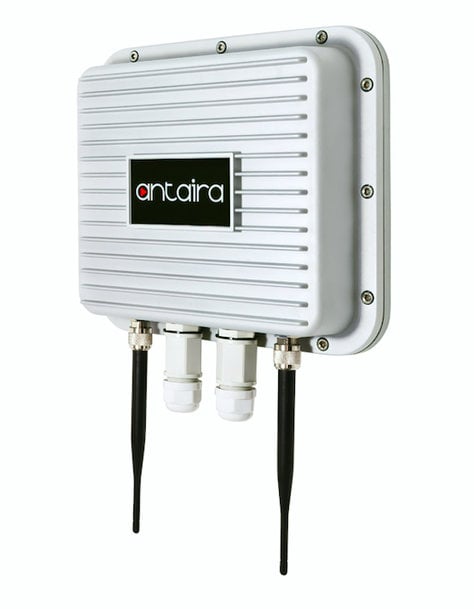Wifi Bridge vs WiFi Repeater – What is the Difference?
Article by Hanry Martel, Field Application Engineer, Antaira Technologies.

Whether you are a networking novice, or an experienced administrator, a wireless bridge and a wireless repeater are two different technologies that can be easily mistaken for each other. Although both are used to extend network coverage, they perform vastly different roles. This article will discuss the unique features of a wireless bridge and a wireless repeater. Then, we'll cover how both can add reliability, value, and functionality to your industrial network.
Let's start with the concept of "wireless bridging." In its simplest form, a wireless bridging refers to the process of extending wired network coverage over two or more interconnected wireless access points. The wireless link between the two access points forms a communication bridge allowing data transmissions between devices on either side of the bridge.
The wireless access points configuration uses a private wireless network only accessible by the access points involved in the bridge. One of the major advantages of wireless bridging is the expansion of communications in areas that are too expensive to add communication cabling or in hazardous areas that would typically be off-limits. This type of growth has paid dividends through enhancing operational visibility and laying the groundwork for Industry 4.0 applications.
- In Client mode, the remote Access Points (APs) act as a router by providing isolation to the interconnected wired cable attached to the port interface. Network Address Translation (NAT) is used to create "forwarding rules" that allow communication between the isolated network and the rest local area network.
- In Client Bridge mode, the two access points are configured as an AP/Station pair, forming a wireless bridge. Data travels over the wireless bridge, treating the junction like a wire connection.
- Wireless Distribution System (WDS) offers the same function as a "Client Bridge"; however, with WDS, you manually configure both APs with the SSID and its peer mac-address information. Manually configured APS through WDS offers an extra layer of security and reliability.
A final note: bridging is distinct from routing. Routing doesn't combine separate networks into a single network. Instead, routing provides a means for multiple networks to communicate yet stay independent of each other.
WiFi Repeater
Next, let's discuss what a repeater does.
A wireless repeater regenerates a wireless signal. In a typical configuration, a wireless repeater is connected to a primary AP in a daisy chain fashion and configured to broadcast the wireless network it's connected to. In doing so, a repeater expands the wireless network's coverage area. Wireless repeaters are popular because they are a simple, cost-effective way to increase network coverage.
Think of a wireless repeater as two routers. The first picks up the Wi-Fi signal you want to extend, copies it bit-by-bit, and transfers it to the second that sends it on to the receiver. Multiple repeaters can be linked together to transmit data much further distances. Because repeaters continuously monitor signals generated between LANs, they can greatly enhance network reliability and flexibility.
However, caution must be taken when deciding to add wireless repeaters into you network, here's why; the nature of the wireless signal is half duplex. Meaning a wireless signal can only transmit data in one direction at a time (send or receive), unlike a traditional full duplex wired network that can transmit and receive data simultaneously. Due to this behavior, wireless repeaters can impact network performance; the further along the daisy chain connection the wireless repeater is from the primary network, the slower the network connection becomes.
Antaira's Integrated Solutions
Up to this point, we have discussed bridges and repeaters as separate and unique devices. However, Antaira and other industrial network device makers often will integrate bridges, repeaters and wireless access points into a single hardened unit. This is done for convenience as well as for device protection.
Antaira WAP/bridge/repeaters are engineered for deployment in harsh industrial environments, including utilities, petrochemical processing, outdoor surveillance, transportation and factory automation. Housed in IP67 rated metal enclosures, they are tested to be resistant to electromagnetic disturbances, periods of voltage instability, extreme temperature fluctuations, as well as intense shocks and vibrations.
Antaira WAP/bridge/repeaters are dual band 2.4Ghz and 5Ghz concurrent to meet most wireless network requirements with support for Ethernet Gigabit for transmission up to 867 Mbps. PoE Powered Device models are also available for streamlined installation.
www.antaira.com

